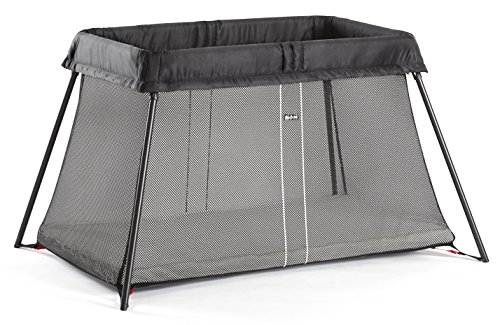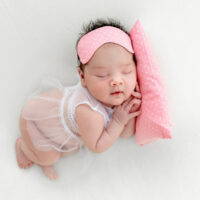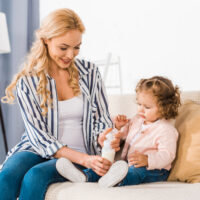A Pack ‘N Play or play yard is a baby registry must-have. It is one of few baby products that you can use from the first day you bring your little one home and for several years after that. Whether you only use baby’s play yard at grandma’s house, when traveling or every night in lieu of a crib, it is important to know when your child has outgrown the pack n’ play and when to stop using it.
Using a Pack ‘N Play for Safe Sleep
Pack ‘N Plays and play yards essentially mean the same thing. They are both portable cribs that also double as a playpen. The name Pack ‘N Play was specifically branded by the company Graco. Check out our top picks for the best Graco Pack ‘N Plays here.
Play yards are approved for safe sleep, according to the AAP (American Academy of Pediatrics). So long as it meets the following criteria: it must include a tight-fitting, firm mattress and a fitted sheet that is designed for that particular product.
Most play yards on the market today can be used from birth. Many feature a bassinet attachment that is included or can be purchased separately. Bassinet attachments allow the play yard mattress to sit higher, so it is easier for mom to reach over and pick baby up for all those middle of the night feedings and diaper changes.
Whether babies sleep in a crib, bassinet, portable crib, or play yard, they must be placed on their backs. This helps reduce the risk of suffocation and death. Little ones should still be placed on their backs to sleep even once they have mastered rolling, which can happen any time from 4 months to 6 months. However, if babies have rolled independently from back to tummy or back to side in their sleep, you do not need to reposition them.
Nothing else should be on the sleep surface, including blankets, pillows, stuffed animals, etc., until the baby is at least one year old.
Pack ‘N Play Height & Weight Limits
When to stop using your play yard for sleep will depend on the manufacturer of the product. For the purposes of this article, we will take a look at the height and weight limits for a few of the most popular play yards on the market. For the most part, you should stop using play yards for sleep once toddlers can climb out of the portable cribs themselves.
Graco Pack ‘N Play On the Go Playard
Parents should stop using the Graco bassinet function on the On the Go Playard when infants begin to push up on their hands and knees or weigh more than 15 pounds (6.8 kg), whichever comes first. This is to prevent falls over the sides of the pack ‘n play.
Once you drop the mattress, babies should graduate from Graco pack ‘n plays when they reach 35 inches (89 cm) in height, weighs more than 30 pounds (14 kg), or are able to climb out.
Regardless of whether play yards are used for sleep or play, large toys and other objects that could be used as steps for climbing out should be removed when children are able to pull to a standing position.
4moms Breeze Plus Portable Play Yard
The 4moms Breeze Plus Play Yard is a popular choice because of how easy it is to set up.
It takes just one push to open and close without having to mess with the side railings. This model includes the play yard, mattress, bassinet, and diaper changing station.
The bassinet can be used from birth to 18 pounds. The flip changer can be used for up to 25 pounds. The play yard can be used for up to 30 pounds.
Chicco Lullaby Zip All-in-One Portable Play Yard
The words machine washable should be music to any mom’s ears, and that’s what you get with the Chicco Lullaby Zip All-in-One Portable Play Yard.
The Chicco play yard includes an infant bassinet, changer, and play yard. The fabric on the changer and play yard can be zipped off easily and thrown in the washing machine. It doesn’t get easier than that!
Here are the weight requirements for the Chicco play yard features:
- Infant bassinet: for babies up to 15 pounds
- For diaper changer: for babies up to 25 pounds
- For play yard: for babies up to 30 pounds
BabyBjörn Travel Crib Light
As the name suggests, the BabyBjörn Travel Crib Light is one of the lightest play yards available, making it very convenient for families who travel.
It weighs just 13 pounds, which is less than half of a traditional pack ‘n play. However, the BABYBJORN Travel Crib Light does not include an infant bassinet.
It is designed for newborns to children approximately 3 years of age, or whenever toddlers can climb out of it. There is no upper weight limit for the travel crib.
Lotus Travel Crib
Not just a portable crib, the Lotus Travel Crib by Guava Family was designed as a travel crib and for families who trek through airports and other modes of transportation.
When folded up, the Lotus Travel Crib fits into the included carry bag, which converts into a backpack to keep you hands-free when traveling. It only weighs 13 pounds. The Lotus play yard also features a mesh, side panel that can be unzipped and locked for easy access to your baby.
Because the mattress is supported by the floor, there is no upper weight limit for the Lotus Travel Crib. You should stop using it once your little one can climb out of the travel crib, which Guava Family estimates to be about 3 years.
Note: the Lotus Travel Crib mattress is not compatible with the traditional pack ‘n play fitted sheets.
Joovy Room Squared Play Yard
From the ultra-compact to the roomiest, the Joovy Room Squared Play Yard is about 50 percent larger than traditional play yards with over 10 square feet of space.
It is designed for multiple children to play in the play yard. However, when using the play yard for sleep, only one child should be placed on the included mattress. The play yard accommodates babies from birth to 35 pounds.
If you have multiples, the Joovy Room Squared Play Yard could be a great option. You can purchase the Twin Nursery Center separately to pair with the Room Squared Play Yard. It includes a bassinet and changing table. The bassinet holds two babies up to 15 pounds each and includes a divider for two separate napping areas. The changing table holds baby up to 25 pounds.
FAQs – Using Play Yards for Safe Sleep
Should I add a mattress?
You do not need to add a mattress beyond the one that is provided with the play yard. You’re probably thinking that your little one will be uncomfortable sleeping on that thin, firm mattress. But rest assured, they are perfectly comfortable and, more importantly, safe.
To us adults, the provided mattress is a far cry from the plush sleep surfaces that we are used to. But remember that the AAP and other infant sleep experts recommend a firm mattress to reduce the risk of Sudden Infant Death Syndrome, or SIDS.
In addition, adding another mattress on top of the one provided could provide a gap between the sleep surface and the sides of the play yard. This creates an unnecessary risk of your infant becoming trapped in that space.
Should I add extra bedding?
Many Pack ‘N Play mattresses are made of waterproof and easy to clean fabrics, such as vinyl. This is by design so that parents and guardians do not layer additional waterproof coverings on top of the play yard mattress.
That being said, it is safe to add a tightly fitted sheet that is made specifically for play yards on top of the mattress. Note: the sizes of play yard sheets and crib sheets are different and not interchangeable. Crib sheets are larger. It is important that there is no extra fabric on your baby’s sleep surface to reduce the risk of suffocation.
What about a blanket? My baby might get cold when sleeping.
Regardless of whether your newborn is sleeping during naps and nighttime in a crib, bassinet, or play yard, you should never place a blanket with them. The AAP recommends that loose bedding stays out of the crib until at least 12 months of age.
Experts recommend baby’s room be cool when sleeping. The recommended temperature is 68 to 72 degrees Fahrenheit. Again, this is to reduce the risk of SIDS. Overheating has been linked to an increased risk of SIDS, according to the National Institutes of Health.
A wonderful alternative to loose bedding for newborns, infants, and toddlers are age-appropriate swaddles and wearable blankets. When babies are first born, they have a startle reflex called the Moro reflex that often jerks them awake. Swaddles are designed to keep their arms at their sides to dampen this reflex. Swaddles also help newborns feel snug and create the womb-like environment they are familiar with.
For older infants who have mastered rolling, arms-free wearable blankets will keep them warm and cozy without needing a blanket. My toddler still uses a wearable blanket for naps and sleep, and they have been a great deterrent for climbing out of the crib!
A good rule of thumb is to dress baby in similar layers to what you are wearing to sleep. For example, if you sleep in a short-sleeve shirt and shorts plus a blanket to sleep, baby should be dressed similarly in a short sleeve onesie and a wearable blanket. If you’re wearing long sleeve pajamas with a comforter on top, consider a long-sleeve footed onesie for your little one and a wearable blanket.
Many swaddles and wearable blankets come in a variety of fabrics, including microfleece and cotton, to accommodate different seasons and the temperature in baby’s room.
How long should baby’s play yard be in a parent’s room for nighttime sleep?
The official recommendation from the AAP is that infants should sleep in their parent’s room for at least 6 months but preferably a year. The bassinet, crib, portable crib, or play yard should be placed close to the parent’s bed. Infants and their parents should never share a sleep surface.
That being said, how long you decide to room share is a personal decision. It is convenient to have your baby sleep in your room on a separate surface for the first few weeks and months because he or she is waking frequently in the night for feedings and diaper changes.
However, once baby starts sleeping longer stretches, parents may find that everyone sleeps better when little ones are in their nurseries.
Final Word
Bottom line: when your little one outgrows a play yard will depend on your specific child. Each baby grows at a different pace, so it is hard to pinpoint what age you need to stop using a pack ‘n play.
That being said, rest assured that you will get a lot of mileage and use out of a play yard. It is likely to last you several years, which is more than you can say for most baby products you will use. Be sure to always check the height and weight guidelines from the manufacturer of the play yard your family is using.












